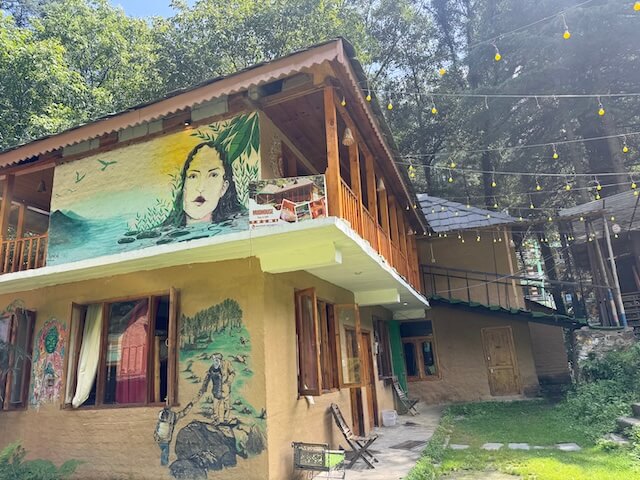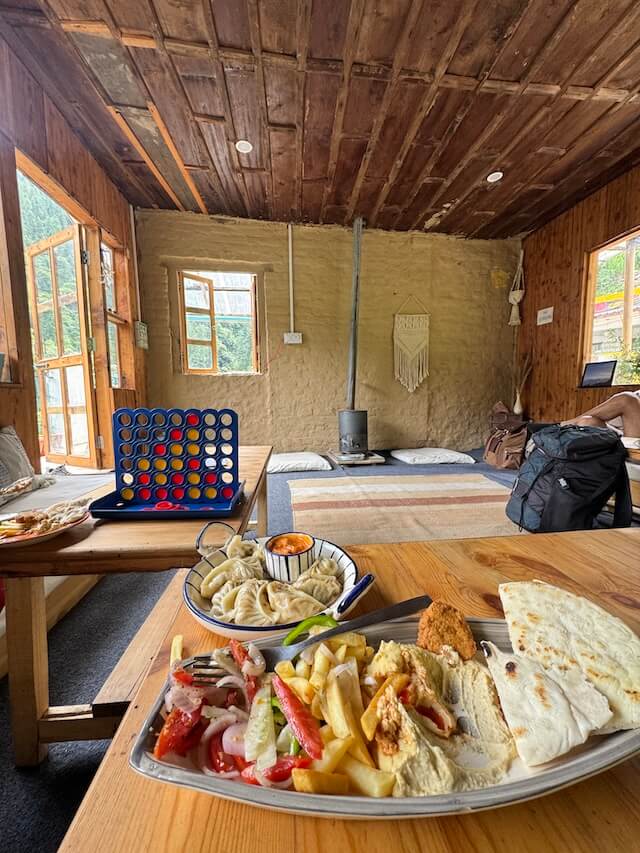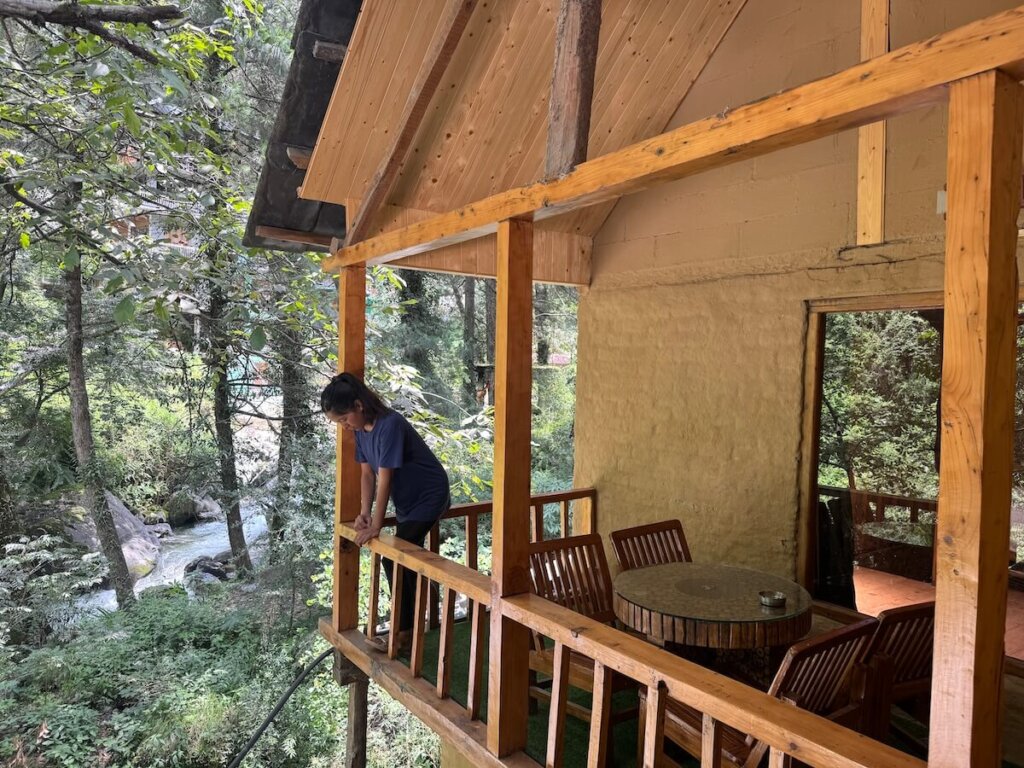The first time I arrived in Jibhi, it felt like stepping into a fairy tale. Tucked away in the Tirthan Valley, this tiny Himalayan hamlet is a world away from the crowded tourist hubs of Manali and Shimla. With its wooden cottages, gushing rivers, dense pine forests, and misty mountains, Jibhi is often called “Mini Thailand” for its tranquil, tropical-like vibe—minus the beaches, of course.
I first stumbled upon Jibhi in 2019 while searching for an offbeat escape. Watch the video below…
Since 2019, I’ve returned four times, each visit revealing new hidden trails, cozy cafes, and unforgettable sunsets. Whether you’re a solo backpacker, a couple looking for a romantic getaway, or a digital nomad in need of a peaceful retreat, Jibhi has something magical to offer.
Check YouTube video of my most recent trip to Jibhi in 2025…
Jibhi Travel Guide: All You Need to Know
In this comprehensive Jibhi Travel Blog, I’ll share everything you need to know—how to reach, where to stay (Jibhi Mudhouse, or one of the popular backpacker hostels like Madpackers Jibhi and Whoopers Jibhi, or what this place is popular for – treehouses in Jibhi), best cafes, must-visit spots, and insider tips—based on my personal experiences.

How to Reach Jibhi, Himachal Pradesh
Here are Best Routes & Transport Tips…
By Air: Nearest Airport (Bhuntar, Kullu)
The closest airport is Bhuntar (Kullu), about 50 km (2-3 hours) away. Flights from Delhi and Chandigarh operate sporadically, so booking in advance is key.
- From Bhuntar to Jibhi:
- Pre-booked taxi (~₹2000-2500, best for groups)
- Shared cabs (~₹500 per person) available near the airport
- Bus option: Take a bus to Aut (the nearest major town), then a local cab (~₹800)
Pro Tip: If you’re flying in, try to land before 3 PM—mountain roads get tricky after dark. Also, the best is to catch a flight to Chandigarh or Delhi and further travel in a bus/taxi as flights to Bhuntar are rare and very expensive.
By Train: Nearest Railway Stations
Jibhi doesn’t have direct train connectivity, but these are the closest options:
Chandigarh (300 km) or Pathankot (200 km) – More reliable, with frequent trains from Delhi.
- From Chandigarh/Pathankot:
- Hire a taxi (~₹4000-5000, 8-10 hrs)
- Take an overnight bus to Aut, then a cab
By Road: The Most Scenic (and Adventurous) Option
From Delhi to Jibhi (~500 km, 12-14 hrs)
- Route: Delhi → Chandigarh → Bilaspur → Mandi → Aut → Jibhi
- Best Options:
- Self-drive (Great for road trips, but be prepared for winding mountain roads)
- Overnight Volvo bus to Aut (~₹1000), then a taxi (~₹800)
From Manali to Jibhi (~80 km, 3-4 hrs via Jalori Pass)
- Jalori Pass route (open May-November) – One of the most breathtaking drives in Himachal!
- Winter alternative: Take the longer route via Mandi if Jalori is closed.
Personal Experience: My first trip to Jibhi was via Jalori Pass, and the views were unreal—rolling green hills, snow-capped peaks, and zero traffic. Just make sure your car has good brakes!
Best Time to Visit Jibhi
1. Spring (March to June) – Best for Trekking & Outdoor Activities
- Temperature: 15°C to 30°C (pleasant days, cool nights)
- Why Visit?
- Perfect weather for trekking to Serolsar Lake
- Rivers are full, making trout fishing ideal
- Less rain, clear skies for photography
2. Monsoon (July to September) – Lush Greenery but Risky
- Temperature: 12°C to 25°C
- Pros:
- Verdant landscapes – Feels like a rainforest!
- Fewer tourists, cheaper stays
- Cons:
- Landslide risk on mountain roads
- Some treks may be closed
3. Autumn (October to November) – Golden Forests & Perfect Weather
- Temperature: 10°C to 22°C
- Why I Love This Season:
- Fall foliage turns Jibhi into a golden paradise
- Great for bonfire nights at Jibhi Mudhouse
- Best time for stargazing (clear skies)
4. Winter (December to February) – Snowy Wonderland
- Temperature: -5°C to 15°C (snowfall in Jan-Feb)
- Highlights:
- Snow-covered cottages & frozen waterfalls
- Cozy vibes – perfect for hot chocolate by the fireplace
- Challenges:
- Some homestays close due to extreme cold
- Roads can be blocked after heavy snowfall
Personal Recommendation: October-November is my favorite—cool weather, stunning colors, and fewer crowds.
Check out below video for Unique stays in Jibhi.
Jibhi is India’s Most Unique Staycation Destination – with Treehouses, Glass Cabins & More!”
The unbelievable variety of experiential stays you find in Jibhi makes it special. You won’t find so many unique stays in one place anywhere else in the country!
Imagine waking up in a cozy treehouse surrounded by pine forests, staying in a stunning glass cabin with panoramic mountain views, or sleeping under the stars in a futuristic geodesic dome. Jibhi offers it all—A-frame cottages, Swiss-style log huts, and even charming Himalayan homestays, each designed to blend with nature while giving you a one-of-a-kind experience.
No other place in India packs so much magic into one tiny village.
Where to Stay – Best Hotels, Homestays & Treehouses in Jibhi
1. Jibhi Mudhouse (My Absolute Favorite!)
- Why Stay Here?
- Rustic mud cottages with private sit-outs overlooking the valley
- Bonfire nights under the stars
- Super friendly hosts who feel like family
- Price: ₹1500-3000/night
- Booking: Airbnb or direct message them on Instagram
Personal Story: I stayed here in July 2025 during monsoon. Waking up to a rainy day and watching the valley with chai in hand is pure magic.
2. Madpackers Jibhi (Best for Solo Travelers & Backpackers)
- Vibe: Social, budget-friendly, great for meeting fellow travelers
- Facilities:
- Dorm beds (~₹500) and private rooms
- Organized treks & local experiences
- Why I Recommend It: You get to meet some travel buddies here. They have a pool table as well.
3. Whoopers Jibhi (Luxury Amidst Nature)
- Swiss-style wooden cabins with mountain views
- Perfect for couples – private, romantic, and serene
- Price: ₹2500-5000/night
4. Jibhi Tree Houses (Unique Stay Experience)
- Top Picks:
- The Himalayan Tree House (₹2000-4000) – Suspended among pine trees
- Jibhi Woods – Private, with panoramic valley views
Pro Tip: Book at least a month in advance for peak seasons (May-June, Dec-Jan).

Best Cafes & Restaurants in Jibhi – Where to Eat
1. Pink House Cafe (Most Instagrammable Spot!)
- Must-Try: Nutella pancakes, ginger lemon honey tea
- Vibe: Cozy, filled with books and board games
- Why I Love It: Perfect for lazy afternoons with a book
2. Rainbow Cafe (Riverside Dining Experience)
- Specialties: Fresh trout fish, pasta, Himachali thali
- Best Seat: The wooden deck by the river
3. Jibhi Kitchen (Authentic Local Flavors)
- Must-Have: Siddu (steamed bread with ghee), momos
Food Tip: Most cafes close by 9 PM, so carry snacks if you’re a night owl!
Top Things to Do in Jibhi & Tirthan Valley
1. Jibhi Waterfall (Hidden Gem!)
Tucked away in the dense forests just 2 km from Jibhi village, this cascading waterfall remains one of the area’s best-kept secrets. The easy 30-minute hike through pine-scented trails leads you to a multi-tiered cascade with crystal-clear pools perfect for a refreshing dip.
Locals recommend visiting at dawn when golden sunlight filters through the trees and you’ll likely have the entire place to yourself. Don’t forget your camera – the moss-covered rocks and shimmering water create magical photo opportunities.
-
Location: 2 km from the main village (easy hike)
-
Best Time to Visit: Early morning (fewer people, soft sunlight)
2. Serolsar Lake Trek (A Must-Do!)
This enchanting 8 km round-trip trek beginning at Jalori Pass takes you through some of Himachal’s most breathtaking landscapes.
The moderately challenging 3-4 hour hike winds through ancient deodar forests before revealing the stunning Serolsar Lake, its glassy surface perfectly reflecting the surrounding snow-capped peaks.
According to local legends, the lake is sacred to Goddess Seroli, and you’ll often find small temples and prayer flags along its shores. The best time to trek is between May-October when the trail is snow-free.
-
Distance: 8 km from Jalori Pass
-
Difficulty: Moderate (3-4 hrs round trip)
-
Reward: A pristine lake surrounded by ancient deodar trees
3. Riverside Camping Near Tirthan River
For an unforgettable night under the stars, head to the camping sites near Gushaini village along the Tirthan River. For ₹1000-2000, you’ll get a comfortable tent, delicious home-cooked meals, and the mesmerizing soundtrack of gushing water.
Many operators offer bonfire setups where you can grill fresh trout while swapping stories with fellow travelers. The clearest nights reveal an incredible Milky Way display – something city dwellers rarely experience.
-
Best Spot: Near Gushaini village
-
Cost: ₹1000-2000 (includes tent, bonfire, meals)
4. Chehni Kothi
This 1500-year-old stone tower near Chehni village has earned its “Mini Thailand of Jibhi” nickname from Instagrammers captivated by its exotic backdrop.
The seven-story structure, one of the last remaining traditional Himalayan towers, stands dramatically against a panorama of lush valleys and snow peaks. Photographers swear by the golden hour before sunset when the entire valley glows.
Local guides can share fascinating stories about the tower’s historical significance in the region’s defense system.
-
What’s Special? A 1500-year-old tower with epic Himalayan views
-
Photography Tip: Sunset lights up the entire valley in gold
5. Trout Fishing in Tirthan River
The icy waters of Tirthan River are a paradise for anglers, teeming with rainbow and brown trout. From March-June, you can obtain a ₹500 daily permit from the fisheries department in Gushaini to try your hand at this peaceful sport.
Many homestays provide fishing gear and packed lunches for full-day excursions. Even if you don’t catch anything, the experience of standing knee-deep in the crystal-clear river surrounded by mountains is worth the trip alone.
Local cafes will happily cook your catch for dinner if you’re lucky enough to reel one in.
-
Permit Needed: Yes (~₹500/day)
-
Best Season: March-June
Offbeat Experiences in Jibhi
- Stay in a Glass Cabin (Try The Hideout Jibhi)
- Village Walk to Raghupur Fort (Ancient ruins with zero tourists)
- Bonfire Nights at Jibhi Mudhouse (Unforgettable memories!)
Budget & Travel Tips for Jibhi
- Daily Budget: ₹1500-3000 (mid-range stay + meals)
- ATM Warning: Last reliable ATM is in Aut—carry enough cash!
- Mobile Network: BSNL/Airtel works, Jio is patchy
- Packing List: Warm layers, trekking shoes, power bank
Final Thoughts: Is it Worth Visiting?
Absolutely. Jibhi is one of those rare places that feels untouched by mass tourism. Whether you stay at Jibhi Mudhouse, Madpackers, or a treehouse in Jibhi, the slow pace, fresh mountain air, and stunning landscapes will leave you refreshed.

